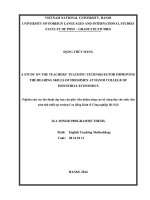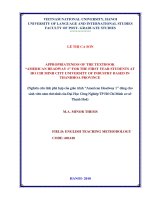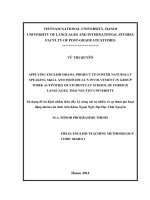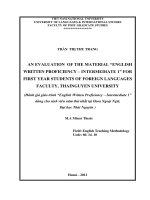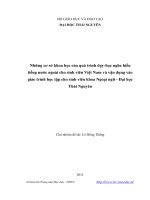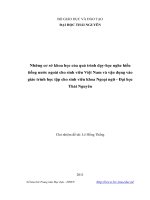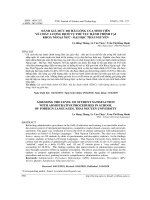Đánh giá giáo trình English written proficiency - intermediate 1 dùng cho sinh viên năm thứ nhất tại khoa Ngoại ngữ, Đại học Thái Nguyên
Bạn đang xem bản rút gọn của tài liệu. Xem và tải ngay bản đầy đủ của tài liệu tại đây (726.22 KB, 58 trang )
VIET NAM NATIONAL UNIVERSITY
UNIVERSITY OF LANGUAGES & INTERNATIONAL STUDIES
FACULTY OF POST-GRADUATE STUDIES
****************
TRẦN THỊ THU TRANG
AN EVALUATION OF THE MATERIAL “ENGLISH
WRITTEN PROFICIENCY – INTERMEDIATE 1” FOR
FIRST YEAR STUDENTS OF FOREIGN LANGUAGES
FACULTY, THAINGUYEN UNIVERSITY
(Đánh giá giáo trình “English Written Proficiency – Intermediate 1”
dùng cho sinh viên năm thứ nhất tại khoa Ngoại Ngữ,
Đại học Thái Nguyên )
M.A Minor Thesis
Field: English Teaching Methodology
Code: 60. 14. 10
Hanoi - 2011
VIET NAM NATIONAL UNIVERSITY
UNIVERSITY OF LANGUAGES & INTERNATIONAL STUDIES
FACULTY OF POST-GRADUATE STUDIES
****************
TRẦN THỊ THU TRANG
AN EVALUATION OF THE MATERIAL “ENGLISH
WRITTEN PROFICIENCY – INTERMEDIATE 1” FOR
FIRST YEAR STUDENTS OF FOREIGN LANGUAGES
FACULTY, THAINGUYEN UNIVERSITY
(Đánh giá giáo trình “English Written Proficiency – Intermediate 1”
dùng cho sinh viên năm thứ nhất tại khoa Ngoại Ngữ,
Đại học Thái Nguyên )
M.A Minor Thesis
Field: English Teaching Methodology
Code: 60. 14. 10
Supervisor: Vũ Thị Thu Thuỷ, M.A
Hanoi - 2011
iv
TABLE OF CONTENTS
CANDIDATE'S STATEMENT i
ACKNOWLEDGEMENTS ii
ABSTRACT iii
TABLE OF CONTENTS iv
LIST OF FIGURES AND TABLES vi
CHAPTER 1. INTRODUCTION 1
1.1. Rationale 1
1.2. Aims of the thesis 2
1.3. Significance of the thesis 2
1.4. The research questions 3
1.5. Scope of the thesis 3
1.6. Methods of the thesis 3
1.7. Organization of the thesis 4
CHAPTER 2: LITERATURE REVIEW 5
2.1 Textbook, Course book, and Materials 5
2.1.1 Definitions 5
2.1.2 The roles of teaching materials in a language program 6
2.2 Materials evaluation 7
2.2.1 Definitions of materials evaluation 7
2.2.2 Types of Materials Evaluation 8
2.2.3 Purposes of Materials Evaluation 9
2.2.4 Materials Evaluators 10
2.2.5 Models for Materials Evaluation 11
2.2.6 Criteria for Materials Evaluation 14
2.3 The Writing Skill 14
2.3.1 Components of the Writing Process 14
2.3.2 Approaches to Teaching and Learning Writing 19
CHAPTER 3: THE STUDY 23
3.1. The Current Teaching and Learning Situation at the Faculty of Foreign Languages, TNU.
23
3.2 Research methods 24
3.2.1 The questionnaire 24
3.2.2. The interview 25
v
3.3. The data collection procedure 25
Chapter 4: DATA ANALYSIS AND DISCUSSION 27
4.1. The Course Objectives 27
4.2. Data collation and analysis 27
4.2.1. Organization 27
4.2.2 Content 30
4.2.3 Methodology 33
Chapter 5: RECOMMENDATIONS AND CONCLUSIONS 37
5.1 Recommendations 37
5.2 Conclusions 38
5.2.1 Results obtained 39
5.2.2 Suggestions for further study 39
APPENDIX 1 I
APPENDIX 2 V
APPENDIX 3 IX
APPENDIX 4 X
APPENDIX 5 Error! Bookmark not defined.
vi
LIST OF FIGURES AND TABLES
Figure 1: The materials evaluation process (by Tom Hutchinson & Alan Waters (1987:98) 12
Figure 2: Producing a piece of writing by Raime A. (1983:6) 16
Figure 3: Martin’s model of genre 21
Figure 4: The data of organization content 28
Figure 5: The data of content criteria 31
Figure 6: The data of methodology criteria 35
Table 1: Example of holistic scale for writing ability (Harris, M. & McCann, P., 1994: 13) 18
Table 2: Example of analytic scale for writing ability (Hedge, 1988: 55) 19
Table 3: The data of organization criteria 28
Table 4: The data of content criteria 30
Table 5: The data of methodology criteria 35
1
CHAPTER 1. INTRODUCTION
1.1. Rationale
English language teaching materials in general and textbooks in particular, together
with students, teachers, teaching methods and evaluation, are the five important
components in language instruction. Although some scholars argue that textbooks limit
teachers and students’ creativeness, few teachers entering a classroom without a textbook
which provides them with contents and learning activities to be conducted in the class.
According to Hutchinson and Torres (1994), a text book is “an important means of
satisfying the range of needs that emerge from the classroom and its wider context.”
Since English was introduced in Vietnam, it has played an undeniably vital role in
the society and become a compulsory subject at schools and universities. Together with
this fact, English textbooks and materials have made a big business for publishing houses.
However, not many attentions have been paid to the evaluation of such textbooks and
materials. Unlike the situations in high schools, where a textbook is used nationwide,
university lecturers often compile teaching materials of their own by referring to different
sources of English books; this leads to a fact that for the same objectives of the course,
different universities use different learning and teaching materials. It is believed that in so
doing, students will study at their best levels. Nevertheless, investigations on how and why
materials are selected by lecturers are surprisingly little. Most of the teachers are subjective
in the materials selection process and they may be unaware of how to judge which texts
best suit their situation. This has inspired me to choose materials evaluation as the theme
for my master thesis.
The second reason for this option lies in the fact that the material I choose to
evaluate, “English Written Proficiency Intermediate 1”, has been in use for two years for
freshmen of English in the Faculty of Foreign Languages (FFL), Thainguyen University,
but there have been no feedbacks from both teachers and students on its effectiveness.
Meanwhile, students’ scores in the final exam on writing skills in previous years were way
lower than their teachers’ expectations with myriad mistakes found on students’ exam
papers. It is essential, therefore, to establish and apply a wide variety of relevant and
2
contextually appropriate criteria for the evaluation of the material to assess its
appropriateness and effectiveness.
1.2. Aims of the thesis
The thesis is aimed at evaluating the material of current use at FFL in terms of
organization, contents, teaching methods commonly used in classroom and at deciding
whether the material is suitable for the students of the faculty with regards to their real
level of English. Hopefully, the findings of this research will provide useful data so that the
researcher can make some decisions on whether to continue using the material for other
generations of students or to make some changes to improve its effectiveness.
1.3. Significance of the thesis
Despite some scholar’s arguments on the usefulness of textbooks to be employed as
instructional material in language learning and teaching, their enormous popularity still
undeniably maintains. The language teachers will then have to assure that “the material
selected closely reflects [the needs of the learners and] the aims, methods, and values of the
teaching program” (Cunningsworth, 1995: 7). However, such a task will not be fulfilled if
there is no thorough evaluation on the material.
Under theoretical significance, this thesis will cater for the methods to evaluate a
teaching material effectively. The researcher will move from subjective assessments to
objective ones. Furthermore, this is the first time a teaching material used in FFL has been
evaluated, so the theoretical background of the thesis will be of some help for other
teaching materials evaluations in the future. Besides, “even though teachers will not
evaluate to adopt materials, they may well be interested in evaluation as a useful process in
its own right, giving insight into the organizational principles of the materials and helping
them to keep up with developments in the field” (Mc Donough and Shaw, 1993: 65).
Under practical significance, the findings of this study will be beneficial to both the
researcher, the teachers who are teaching writing skills for first year students and the
students themselves in FFL. All the strengths and weaknesses of the “English written
proficiency 1” are identified so that optimum use can be made of such strong points, whilst
the weaker areas can be strengthened through adaptation.
3
1.4. The research questions
This thesis is to find out the answers to the following questions:
1. Does the material “English written proficiency – intermediate 1” for first year students
at FFL meet the requirements of the course in terms
(i) Content and the suitability with students’ real level of English?
(ii) Methodology and the suitability with students’ real level of English?
2. Is the material attractively and logically designed?
3. What should be done to help improve the material?
1.5. Scope of the thesis
The focus of this thesis is the criteria set up for evaluators to assess the teaching
material. It includes criteria of format/organization, content and methodology.
The subjects of this thesis are the freshmen of English who have finished their first
term at Faculty of Foreign Languages, Thainguyen University. The subject also includes
the material called “English Written Proficiency – Intermediate 1”, which consists of four
units – each unit is subdivided into two main parts: the reading part and the writing part.
The reading part aims at not only improving students’ reading skills and widening their
vocabulary but also assisting the writing part by providing it with relevant input. The
writing part helps learners develop their competence in writing paragraphs of three types
namely descriptive, narrative and expository.
1.6. Methods of the thesis
In order to achieve the objectives of this thesis, the researcher applies qualitative
research methods. Data are collected through questionnaires and interviews with both
teachers and students.
Questionnaires are an important factor in the process of having an objective
evaluation. The questions are designed to gather data about the teachers’ and students’
ideas on the intended criteria.
Information gained from interviews will be recorded, analyzed and used for
reference in making recommendations to improve the quality of the material.
4
1.7. Organization of the thesis
The thesis comprises five chapters:
Chapter one gives general introduction about reasons for choosing the topic of
study, aims, significance, research questions, scopes, methodology and organization of the
thesis.
Chapter two is devoted to the literature review on materials evaluation. Firstly, a
clear distinction among textbook, course book and materials are made. Then, it discusses
the role of teaching materials in language programs. In the next part, some major issues in
the evaluation of teaching materials, including definitions of materials evaluation,
approaches to materials evaluation, types of materials evaluation and the roles of
evaluation in materials development are presented. The chapter also mentions methods to
evaluate materials and some criteria to be applied in materials evaluation. In addition, as
the book is mainly used to develop students’ writing skills, aspects such as components of
the writing process and approaches to teaching and learning writing are also discussed.
Chapter three presents an overview of the current teaching and learning at FFL,
Thainguyen University and describes the methodology employed in this study, research
methods, data collection procedure, participants, setting as well as data analysis.
Chapter four expounds the collected data, analyzes them and discusses the findings
of the study.
Chapter five offers conclusions on the results obtained and highlights some
recommendations for developing the material.
5
CHAPTER 2: LITERATURE REVIEW
This chapter provides an overview of the theoretical background to the research. It
is divided into three sections. The first section, as the background to the study, briefly
discusses the concepts as well as the distinctions among the term “textbook, course book
and materials”; it also mentions the roles of teaching materials in a language program.
These are the initial steps that help the researcher get to know where to start. The second
section gives an overview of materials evaluation to provide the fundamental basis and
important factors for the researcher to conduct this study. The last section states the
components of the writing process and some approaches to teaching and learning writing.
2.1 Textbook, Course book, and Materials
2.1.1 Definitions
The terms textbook, course book and materials are most commonly found in
learning and teaching. Authors, teachers and learners use them interchangeably; however,
are these terminologies the same?
Oxford Advanced Learners’ English-Vietnamese Dictionary explains textbook as
books giving instruction in a subject. This term is also defined by Microsoft Encarta (2005)
as a book that treats a subject comprehensively and is used by students as a basis for study.
For many teachers, textbooks are the instruments that help them to explain and express
their teaching ideas. In most courses, there is a single textbook used as the core, while
teachers can supply other materials at their wishes.
The term “course book” is used to refer to a textbook on which a course is based. In
English language teaching, it is defined more specifically by Tomlinson (1998) as:
a textbook which provides the core materials for a course. It aims to provide as
much as possible in one book and is designed so that it could serve as the only book which
the learners necessarily use during a course. Such a book includes work on grammar,
vocabulary, pronunciation, functions and the skills of reading, writing, listening and
speaking.
(Tomlison, 1998: ix)
6
There are different viewpoints about teaching materials. According to Dudley-
Evans and Maggie Jo St John (1998: 170), materials can be used as a source of language, a
learning support, for motivation and stimulation, and for reference.
In Tomlinson’s opinion (1982: 2), language teaching materials are anything which is used
by teachers or learners to facilitate the learning of a language. “It can be in the form of a
textbook, a workbook, a cassette, a CD-Rom, a video, a photocopied handout, a newspaper,
a paragraph written on a white board; anything that presents or informs about the language
being learned”. Among these, in the local setting, textbooks are the most widely used
materials in language teaching.
Encyclopedia explains teaching materials as follows: 1) a system of knowledge and
skill which is compiled and organized according to the task of a certain subject, and which
has a certain extension and depth; 2) all the materials that are used by teachers to supervise
the students’ study.
Hutchinson (1987:37) asserts that materials are not simply the everyday tools of the
language teacher; they are an embodiment of the aims, values and methods of a particular
teaching/learning situation. As such the selection of materials probably represents the
single most important decision that the language teacher has to make.
In this thesis, the terms “textbook”, “course book” and “materials” are used
interchangeably for the convenience of analysis and explanation.
2.1.2 The roles of teaching materials in a language program
Teaching materials have a significant role in a training program as well as in the
professional lives of teachers. According to Richards, there are several reasons why
textbooks dominate what teachers teach and what learners learn. Firstly, they provide
structure for a program. Without textbooks, a program may have no central core and
learners may not receive a syllabus that has been systematically planned and developed.
Secondly, they help standardize instruction. The inclusion of a textbook in one program
can assure the similarity in terms of contents different classes may receive; thus students
will be tested in the same way. Thirdly, they can maintain quality if a well-developed
textbook is used. Teachers, whose first language is not English and who may be
inexperienced in teaching, can use textbooks as media of initial teacher training.
7
Harmer (1991: 257) also observes that where a course book is involved, there are
advantages for both teachers and students. For students, the course book allows them to
look back and forward, giving them a chance to prepare for what is coming and to review
what they have done. For teachers, it helps them save time; thus, they can devote
themselves more in improving their teaching quality.
Other linguists also share the same opinions about the importance of teaching
materials in a language program. Hutchinson and Torres (1994:315) suggest that “No
teaching-learning situation, it seems, is complete until it has its relevant textbook”.
Textbook is considered the “visible heart” of any program.
Beside the aforementioned belief in the vital role of teaching materials, some
researchers and practitioners hold the less favorable ideas on the issue. Allwright (1982),
for instance, suggests that textbooks are too inflexible and generally reflect the pedagogic,
psychological, and linguistic preferences and biases of their authors.
It is generally accepted that the role of the course book is to be at the service of
teachers and learners, but not to be their master. With the availability of teaching materials
nowadays, teachers need to be knowledgeable enough to choose the most suitable ones for
their students; after that, they should exploit these materials flexibly and effectively so that
students can benefit the most in the teaching and learning process.
2.2 Materials evaluation
2.2.1 Definitions of materials evaluation
Microsoft Encarta defines “evaluation” as “an assessment of value; the act of
considering or examining something in order to judge its value, quality, importance, extent,
or condition”. Linguistic researchers also have their ways of defining this term without
changing the purposes of judging program’s accountability, and bettering curriculum when
carrying out an evaluation.
According to Tomlinson (1998), evaluation is “the systematic appraisal of the value
of materials in relation to their objectives and to the objectives of the learners using them”.
This definition is well aligned with the learner-centered approach, in which learners’ needs
and goals are carefully put into consideration to see to what extent the learning points are
useful to them. Evaluation is also defined as assessment by some linguists; however,
8
Nunan, D (Anthology Series 27, 1991: 46), differentiates the two terms. In his opinion,
“evaluation” is a wider term than “assessment”. In “evaluation”, not only information on
what learners can do with the target language is gathered, additional processes designed to
help us in analyzing and acting on the result of our assessment are also involved.
Additionally, he shares the idea with Hutchinson & Waters, A. that “evaluation is not
simply a process of obtaining information; it is also a decision-making process”. Besides,
from their point of view, Rea-Dickens and Germaine (1992) states that “evaluation is the
means by which we can gain a better understanding of what is effective, what is less
effective, and what appears to be of no use at all”, (Rea-Dickens, P. & Germaine, K.
1992:4). Other researchers who hold similar opinions to the ones mentioned above are
Dudley – Evans & St. John. According to them, evaluation is a complete process “which
begins with determining what information to gather and ends with bringing about change
in current activities or influencing future ones”, (Dudley – Evans & St. John, 1998:128).
In general, we can conclude that evaluation is a process through which the
usefulness and effectiveness of a language course, a teaching curriculum and a collection
of teaching materials are brought into light. The information gathered from this process can
be used to create adjustments for future improvements in the teaching and learning
activities. The process of evaluation in general and materials evaluation in particular
include both data collection and analyses as well as action. In other words, the following
key questions must be seriously put into consideration (Tomlinson 1998: 192): What
aspects (of materials) should we examine? How can we examine (materials)? and How can
we relate the findings to our own teaching contexts?.
2.2.2 Types of Materials Evaluation
Depending on the circumstances and purposes of the materials evaluation, the
process can take place before the materials are used, while they are being used and after
they have been used. Among these, the pre-use evaluation seems to be the most difficult
since there is no actual experience of using the book in teaching and learning. Tomlinson,
B (2003: 23), in categorizing types of materials evaluation, divides it into three types: pre-
use evaluation, whilst-use evaluation and post-use evaluation.
9
- Pre-use evaluation: this is about the predictions on the potential value of materials
for their users. For example, in order to choose a course book for a subject, teachers may
flick through some book to gain a quick impression of their potential values then choose
the one which, in their opinion, is the most appropriate.
- Whilst-use evaluation: this involves measuring the values of materials whilst using
them or whilst observing them being used. Tomlinson suggests criteria to be included in
this kind of evaluation as follows: clarity of instructions, clarity of layout,
comprehensibility of texts, credibility of tasks, achievability of tasks, achievement of
performance objectives, potential for localization, practicality of the materials, teachability
of the materials, flexibility of the materials, appeal of the materials, motivating power of
the materials, impact of the materials, effectiveness in facilitating short-term learning
(Tomlinson, B. 2003: 24).
- Post-use evaluation: this kind of evaluation seems to be the most valuable as it can
measure the actual effects of the materials on the users. The actual outcomes and the data
gathered in order to make reliable decisions are measurable.
The kind of evaluation in this thesis is post-use evaluation in alignment with
qualitative approach. It aims at validating the merits of the in-house writing material being
used for freshmen at FLF and suggesting positive changes for future use.
2.2.3 Purposes of Materials Evaluation
Basing on what purposes evaluation serves, Rea-Dickins, P and Germaine, K (1992)
subdivide the process into different types with different characteristics.
Firstly, evaluation may be undertaken for accountability. “Accountability” simply
means evaluating something to see whether something is intrinsically a “good thing” or not.
The information interpreted from evaluation for purposes of accountability is not used for
improving the curriculum. Rather, it informs decisions as to whether something is to
continue or be discontinued. It is believed that any evaluation having such characteristics is
known as summative evaluation. Another purpose of evaluation is to develop curriculum.
In this process, information from teachers and other relevant English language teaching
professionals will be collected over a period of time. The teachers are the ones who know
most clearly about their classroom contexts, they, therefore, have great contributions to
10
make in evaluating the strengths and weaknesses of all aspects of learning and teaching.
Such strengths and weaknesses are useful information and can be used as the basis for
future planning and action. For this reason, evaluation for purposes of curriculum
development is called formative evaluation. The last general purpose of evaluation is for
teacher self-development. Rea-Dickins and Germaine (1992) state that “evaluation of this
kind is definitely not concerned with measurement”. Through awareness-raising activities,
teachers are involved in describing and better understanding their own contexts with a
view to improving the teaching and learning process.” This type of evaluation is referred to
as illuminative one.
An evaluation may focus on a variety of different parts of the language teaching of
the language teaching curriculum; each kind of evaluation has its own purposes. The
important thing is when the subject of the evaluation is known, it is necessary to choose
appropriate evaluation procedures in order to achieve such purposes.
2.2.4 Materials Evaluators
So far, the term “evaluator” has been used without any definitions about what
exactly it is. Alderson (1992) and Dudley-Evans and St John (1998) hold the idea that
evaluators can be outsiders or insiders. Outsiders are those who are not involved in the
program, such as consultants, inspectors, and administrators. Insiders are those from within
the program. Examples for insiders are teachers, learners, course and materials designers.
The reasons for involving outsiders alone in an evaluation process are that outsiders can
guarantee objectivity; they may have greater credibility or offer a fresh perspective. This is
possible as “outsiders can have great professional or public credibility and may see the
issues in a different light (not necessarily clearer) than those in the inside” (Alderson,
1992:279). However, Alderson also argues about the guarantee of objectivity in outsiders’
evaluation. In his opinion, all the decisions made in an evaluation process are based on
judgments which are inevitably subjective. In addition, there may be some disadvantages
of outsiders as evaluators. Outsiders have their own views on language teaching methods.
They may not fully understand the teaching and learning situation in which the evaluation
is being carried out. They, thus, may be unsympathetic and they may need more time to get
to know the local situation such as learners’ needs, facilities as well as constraints,
Robinson (1991). As a result, their judgments may be unreliable, and their
11
recommendations may be unrealistic; even what they find may have already been found
(Dudley – Evans & St. John, 1998).
Insiders, on the other hand, are of great value in the evaluation process. No one can
understand the learning and teaching situations better than them as they are a crucial part of
the program. As Alderson (1992) addresses, “What is indisputable is that insiders have an
experience and a knowledge of a program that can be invaluable to an evaluation”.
Richards (2002) also shares the same point of view “as a sequence, they (insiders) will
have a greater degree of commitment to acting on its results” (p.296). He further suggests
insiders, especially teachers, can “monitor” when the materials are being used. They,
therefore, can determine if and to what extent the materials “work” for their purposes and
thus they can make modifications to improve the effectiveness of the materials. However,
insiders may suffer from disadvantage when they can be “too closed and involved, or lack
expertise” (Dudley-Evans and St. John, 1998: 131). This, in turn, can cause subjectivity in
their judgments.
Alderson and Scott (1992) believe that “both insiders and outsiders should be
involved collaboratively in conducting evaluations at all stages in the process”.
2.2.5 Models for Materials Evaluation
Tom Hutchinson and Waters (1987) recommend four main steps in an evaluation
process:
- Defining criteria
- Subjective analysis
- Objective analysis
- Matching
The following diagram reveals details on the above mentioned steps:
12
Figure 1: The materials evaluation process (by Tom Hutchinson & Alan Waters (1987:98)
The model of these two authors is a macro evaluation which aims at assessing the
workability of an entire set of materials. As can be seen from the figure, this model
presents a logical procedure in the materials evaluation process. In order to test how
suitable a material is to the target students, a system of certain criteria for judgments must
be carefully designed. Furthermore, determining the objectives of the materials so that they
can be used as the framework in testing the effectiveness of the material is a must.
Apart from the model of Hutchinson and Waters, Ellis (1997) suggests a micro-
evaluation. This evaluation is “best carried out in relation to task”. Following Skehan, A
task here is viewed as “an activity in which: meaning is primary; there is some sort of
relationship to the real world; task completion has some priority; and the assessment of
task performance is in terms of task outcome”. Ellis indicates a series of steps in evaluating
a task:
1. choosing a task to evaluate: the task here may be new to teachers, and they want
to discover the effectiveness of using it in classroom. The task can also be the
DEFINING CRITERIA
On what bases will you judge materials?
Which criteria will be more important?
SUBJECTIVE ANALYSIS
What realization of the criteria
do you want in your course?
OBJECTIVE ANALYSIS
How does the material being
evaluated realize the criteria?
MATCHING
How far does the material match
your needs?
13
one which has already been used; teachers want to confirm whether it works as
well as they think it does.
2. describing the task: it can be described in terms of objectives, input, procedures
and outcomes.
3. planning the evaluation
4. collecting the information: the information required to evaluate a task can be
collected before, during or after the teaching of the task.
5. analyzing the information: the data can be analyzed either in quantitative or in
qualitative way.
6. reaching conclusions and making recommendations
7. writing the report
This model of evaluation is more manageable than a macro-evaluation.
Nevertheless, in order to conduct a macro-evaluation, a series of micro-evaluations need to
be carried out, which consumes a lot of time and efforts.
Another model of evaluation, which is a combination of macro-and micro-
evaluation, is also suggested by McDonough and Shaw (1993). In their points of view,
there are three stages in the evaluation models: external evaluation, internal evaluation, and
overall evaluation. The external stage (macro-evaluation) is the examination of the claims
made for the whole materials by the author. The internal stage (micro-evaluation) requires
an in-depth look at two or more units to find out the claims made by the author. This
second stage only happens if, in the first stage, the materials are proven potentially
appropriate. If not, there will be no second or third stage. In the last stage, an overall
assessment as to the suitability of the materials by considering whether they are usable
(how far the materials could be integrated into a particular syllabus as “core” or
supplementary), adaptable (can parts be added, extracted, used in another context for local
circumstances?), flexible (can the materials be entered at different points or used in
different ways?), McDonough & Shaw (1993).
In brief, all of the above models serve to evaluate the appropriateness of a set of
materials to a certain situation or group of learners despite the various processes and
purposes in each model. Evaluators must then base on the purposes of the evaluation, time
available, facilities as well as the constraints of the context where the evaluation occurs to
14
decide which model to follow. The author of this thesis intentionally uses the model of
Hutchinson and Waters (1993).
2.2.6 Criteria for Materials Evaluation
In order to make objective judgments, evaluators need a system of criteria. Criteria
are what evaluators use to “reach a decision regarding what needs to be evaluated”
(Tomlinson, 1998: 220). Defining criteria is one of the initial steps to put into
considerations before carrying any evaluation.
Hutchinson and Waters (1987) suggest a checklist in the process of evaluating materials:
- Audience: the learners and the learners the materials intended for with regards to
different information such as ages, sex, professional fields, knowledge of English,
educational background, and so on
- Aims: the aims of the materials
- Content: language description, language points, macro-skills and their proportion,
micro-skills, subject-matters in terms of level of knowledge, types of topics,
organization and sequence of content.
- Methodology: theories of learning, teaching-learning techniques, kinds of exercises,
guidance for teaching, the flexibility of materials.
- Other criteria: price, availability of the materials or their attractiveness.
Beside the checklist of Hutchinson and Waters, evaluators may employ a set of
criteria by Sheldon (1988). The set includes: rationale, availability, layout/graphic,
accessibility, linkage, selection/ grading, physical characteristics, appropriacy, authenticity,
cultural bias, educational validity, stimulus/ practice/ revision, flexibility, guidance and
overall value for money. In different situations, upgrading, modification and extension to
these criteria are necessary to suit the specific requirements.
In this thesis, the author mainly uses the five criteria given by Hutchinson and
Waters in order to have unity and manageability.
2.3 The Writing Skill
2.3.1 Components of the Writing Process
15
Writing in general and writing in a foreign language in particular is always one of
the most challenging tasks a student has to cope with. Even native speakers at university
level often experience serious difficulties in showing a good command of writing. This
leads to the inclusion of teaching writing skills in a foreign language syllabus as these
skills are considered essential for students’ academic success. There are two sides of the
learning and teaching written English: writing as a channel and writing as a goal of foreign
language learning.
In the first side, writing is widely used within foreign language courses as a
convenient means for engaging with aspects of language other than the writing itself. For
example: writing exercises are given to consolidate what students have learnt and orally
practice in terms of vocabulary, grammatical structures. Apart from being used as a means
of getting the students to attend to and practice a particular language point, writing can be a
convenient method of testing the language point. The latter side indicates that students
learn a language in order to communicate, both in spoken and written form. For this reason,
writing tasks should have whole pieces of information as their outcome, rather than
isolated sentences in order to help them develop the skills of communicating in writing. In
other words, students should have practice writing at both micro-level and macro-level.
They may have to write reports, letters; give written instructions; fill out forms in their
future jobs, so the writing skill is very necessary for them.
The question one should ask here is “What do writers need to actually produce a
piece of writing (clear, fluent and effective communication of ideas?”. Raimes, A. (1983)
suggests a set of considerations in order to have an effective piece of writing shown in
Figure 2.
Why do learners need a purpose to write? Traditionally, narrative, descriptive,
argumentative, and expository are the main types of writing. Recently, some authors
discuss other forms of written discourse, such as expressive, persuasive, literary, and
referential. For each of these types, learners need to have clear reasons when they are asked
to produce any piece of writing. Teachers’ task here is to provide a context and make them
clear of the purpose. Writing with a purpose means writing to an audience. In reality, we
usually write something with a particular type of readers in mind, it is essential that
learners also consider their audience when they write. The writing task should specify not
only why they are writing, but also for whom. When writers are concerned about their
16
audience, they should develop the content clearly and convincingly. The ideas should be
relevant and deal with the topic or purpose suggested, without including unnecessary
points or losing track of their subject. The ideas and information in sentences as well as
paragraphs must be linked to make the writing coherent. The audience will certainly
appreciate a careful and efficient structure of the text. The writer’s use of language should
also be accurate: the rules for verbs, articles, pronouns, prepositions, sentence structures,
word order should be specially paid attention to. Moreover, punctuation and spelling are
also essential elements, together with clear writing, margins, and consistent indentation.
Figure 2: Producing a piece of writing by Raime A. (1983:6)
In the above section, we mentioned macro- and – micro- levels for writing without
going into any details. In what follows, the author will present some linguists’ points of
view in these two matters. In terms of macro-level for writing, Palmer (1991) suggests a
set of sub-skills: (1) graphical or visual skills, which pay attention to students’ ability of
organizing information, using punctuation, spelling, capitalization and format; (2)
grammatical skills, which refer to the ability to use successfully a variety of sentence
patterns; (3) expressive or stylistic skills, which consider students’ ability to express
meanings in various styles or registers; (4) rhetorical skills, which are about students’ use
of linguistic cohesion device such as connectives, reference words, etc.; (5) organizational
ORGANIZATION
paragraphs, topics and
support, cohesion and unity
WORD CHOICE
vocabulary, idiom, tone
PURPOSE
the reasons for writing
AUDIENCE
the reader/s
MECHANICS
handwriting, spelling,
punctuation
GRAMMAR
rules for verbs, agreement,
articles, pronouns, etc.
SYNTAX
sentence structure, sentence
boundaries, stylistic choice, etc
CONTENT
relevance, clarity,
originality, logic, etc
THE WRITER’S PROCESS
getting ideas, getting started,
writing drafts, revising
clear, fluent, and effective
communication of ideas.
17
skills; which refer to the way students sequence, reject and summarize relevant points in
their writing.
In terms of micro-skills, Brown (1994, p.327) introduces a list of the related skills
for writing:
1. Produce graphemes and orthographic patterns of English.
2. Produce writing at an efficient rate of speed to suit the purpose.
3. Produce acceptable core of words and use appropriate word order pattern.
4. Use acceptable grammatical system (e.g. tenses, agreement, pluralization),
patterns and rules.
5. Express a particular meaning in different grammatical forms.
6. Use cohesive devices in written discourse.
7. Use the rhetorical forms and conventions of written discourse.
8. Appropriately accomplish the communicative functions of written texts
according to form and purpose.
9. Convey links and connections between events and communicate such relations
as main idea, supporting idea, new information, given information,
generalization, and exemplification.
10. Distinguish between literal and implied meaning when writing.
11. Correctly convey culturally specific references in the context of the written text.
12. Develop and use a battery of writing strategies, such as accurately assessing the
audience’s interpretation, using pre-writing device, writing with fluency in the
first drafts, using paraphrases and synonyms, soliciting peer and instructor
feedback, and using feedback for revising and editing.
So far, we have looked at components and skills included in producing a piece of
writing. What the author wants to focus in the next section is how the piece of writing
should be evaluated. Harris and McCann (1994) develop a set of criteria which are
arranged in holistic scales:
18
Table 1: Example of holistic scale for writing ability (Harris, M. & McCann, P., 1994: 13)
The criteria should also be of analytic scale as the one suggested by Hedge (1988):
Level 1
Level 2
Level 3
Level 4
Level 5
A) General development
1. Content
2. Organization
3. A sense of audience
B) Specific components
4. Grammatical skills
5. Complexity of sentences
6. Use of vocabulary
7. Spelling
8. Punctuation
9. Presentation
Level 1 = Exellent
Level 2 = Good
Level 3 = Adequate
Level 4 = Inadequate
Level 5 = Weak
5. Constructs grammatically correct sentences and phrases and shows full mastery of
appropriate vocabulary. Text is organized coherently. Correct spelling at all times.
Excellent content and presentation. Message wholly relevant.
4. In general, grammatically correct sentences and phrases, but some errors which do not
affect understanding. Does not use appropriate vocabulary at all times. Some difficulties
with organization of text. Some errors in spelling. Good content and presentation.
Message mostly relevant.
3. Grammatical errors and use of vocabulary affect understanding as does organization of
text. Many errors in spelling. Satisfactory content and presentation. Message not always
relevant.
2. Text understood with difficulty due to inaccurate grammar and inappropriate use of
vocabulary. Poor content and presentation. Message generally lacks relevancy.
1. Impossible to understand text due to frequency of grammatical errors and incoherence
of organization. Poor spelling. Message irrelevant.
19
1. Organization of content (clarity, coherence, paragraphs)
20%
2. Range (grammatical structures, vocabulary)
15%
3. Complexity of sentence structures
15%
4. Accuracy of grammar, sentence structure, spelling and punctuation
30%
5. Fluency (feel for the language, appropriateness, use of idioms, etc.)
20%
100%
Table 2: Example of analytic scale for writing ability (Hedge, 1988: 55)
2.3.2 Approaches to Teaching and Learning Writing
It is said that there is no one answer to the question of how to teach writing in
foreign language classes. There are many answers as there are teachers and teaching styles
as well as learners and learning styles. In the history of writing instruction, researchers and
teachers have oscillated between focusing on the written product that students are meant to
produce and focusing on the creative processes of writing (Galbraith and Rijlaarsdam,
1999).
The product approach
Pincas (1982a) provides the most explicit descriptions of product approach. In her
views, writing is primarily about linguistic knowledge, with attention focused on the
appropriate use of vocabulary, syntax and cohesive devices (Pincas 1982b).
In this approach, learning to write involves four stages: familiarization, controlled
writing, guided writing, and free writing. The familiarization stage aims to make learners
aware of certain features of a particular text. In the controlled and guided writing sections,
the learners practice the skills with increasing freedom until they are ready for the free
writing section. Robinson (1991, cited in Hutchinson, T. & Warters, A., 1997: 116)
summarizes this approach in the following way:
20
The strong points of this approach are that it recognizes the need for learners to be
given linguistic knowledge about texts, and they understand that imitation is one way in
which people learn. However, White (1988) and Jordan (1997) argue that adopting such an
approach not only does the very nature of the sequence provide little or no insight into the
actual process involved in managing to arrive at the final product, but the students are also
restricted in what they can write. In other words, knowledge and skills learners bring to the
classroom are undervalued.
The process approach
Tribble suggests that process approach stresses
…. writing activities which move learners from the generation of ideas and the
collection of data through to the “publication” of a finished text. (1996: 37)
Linguistic skills such as planning and drafting are seen as predominant in this
approach. There is much less emphasis on linguistic knowledge, such as knowledge about
grammar and text structure.
Tribble (1996) proposes a cyclical process in which writers may, for example,
return to pre-writing activities after doing some editing or revising : prewriting, composing,
revising (reorganizing/shifting emphasis/focusing information and style for your readership)
and editing (checking grammar/ lexis/ surface features such as punctuation, spelling, layout,
quotation, references).
Another model of the stages in writing is suggested by Tomlinson (1991) as
follows:
The disadvantages of the process approach are that they often regard all writing as
being produced by the same set of processes; that they give insufficient importance to the
kind of texts writers produce and why such text are produced; and that they offer learners
insufficient input, particularly in terms of linguistic knowledge, to write successfully. The
main advantages are that the importance of skills involved in writing is understood and the
approach values what learners bring to the writing classroom as contributions to the
development of writing ability.
Writing task
Draft 1
Feedback
Revision
Input
Draft 2
Feedback
Revision
Draft 3
Model text Comprehension/Analysis/Manipulation New Input Parallel Text

